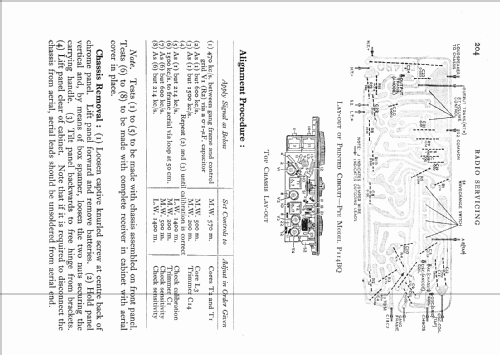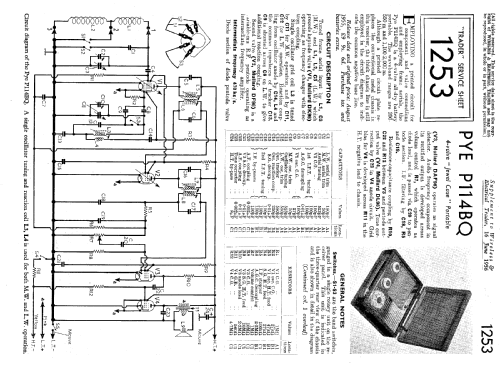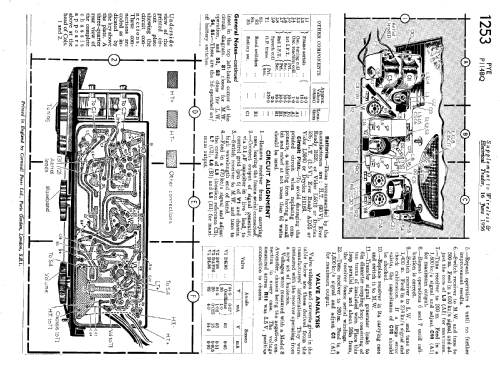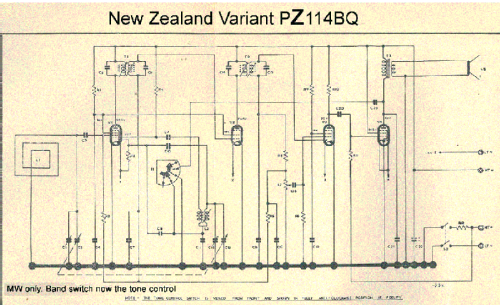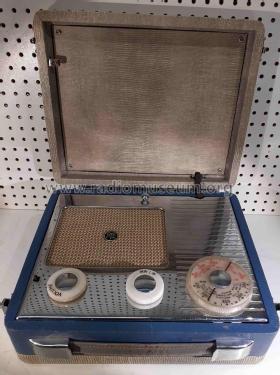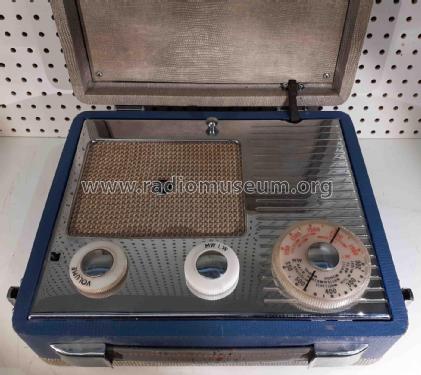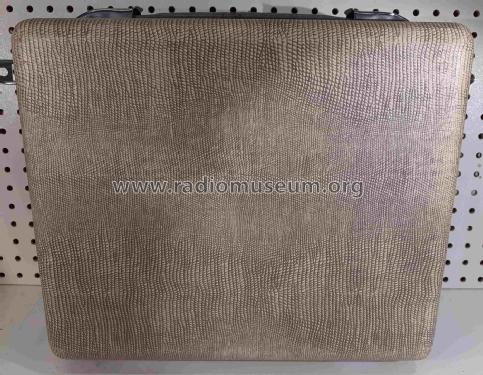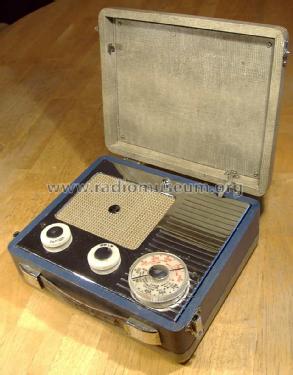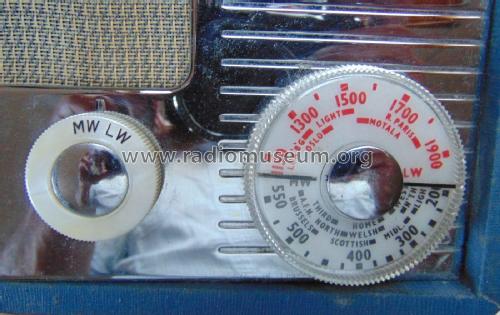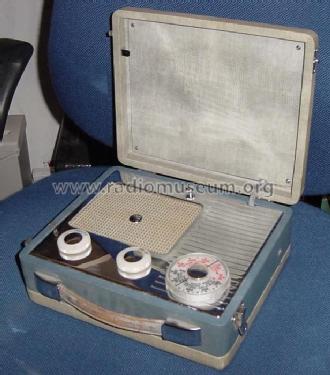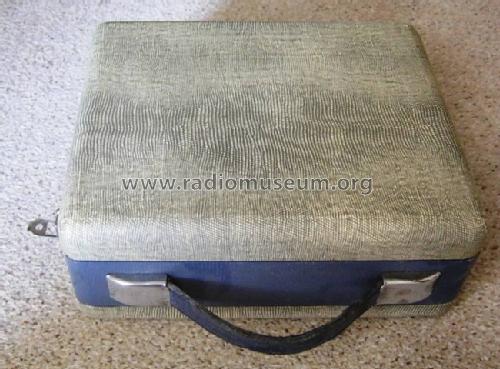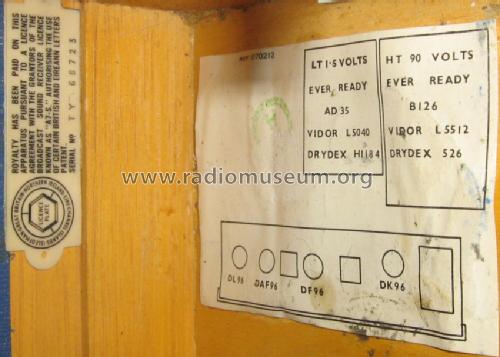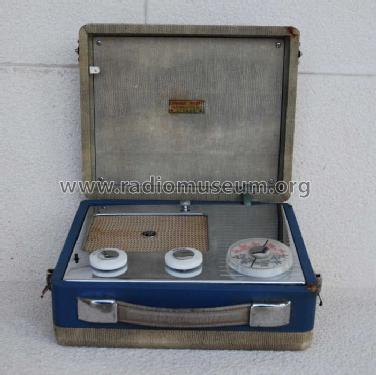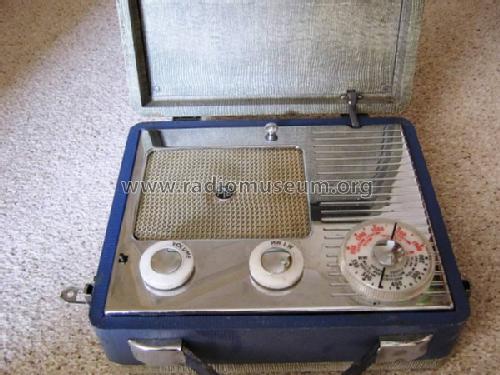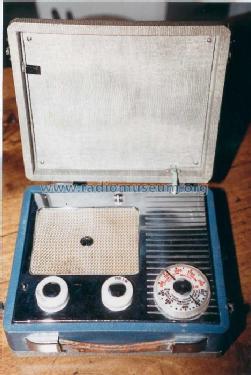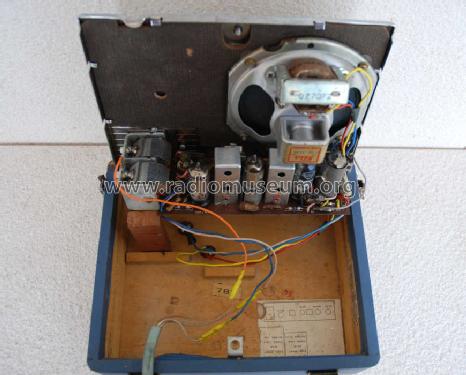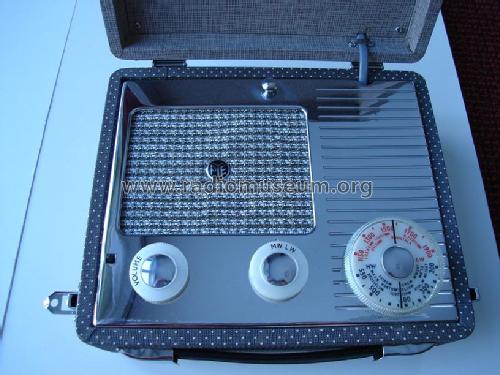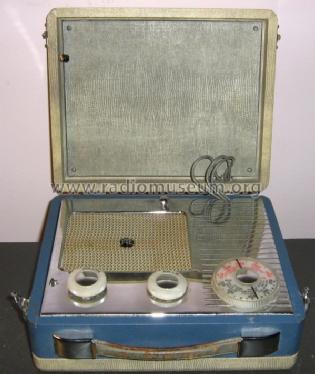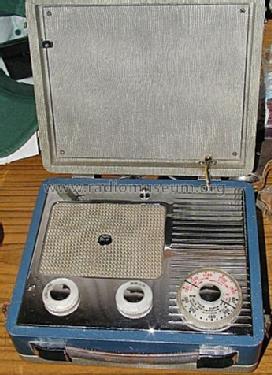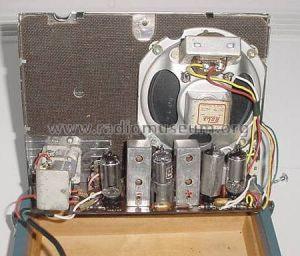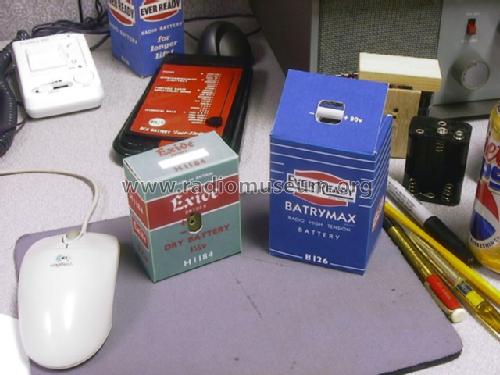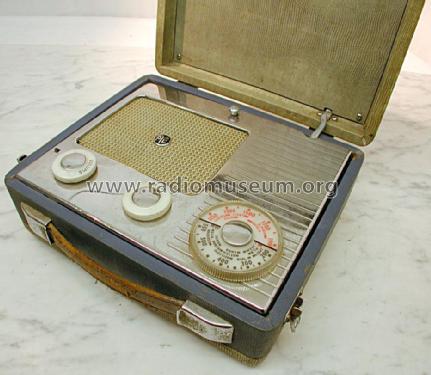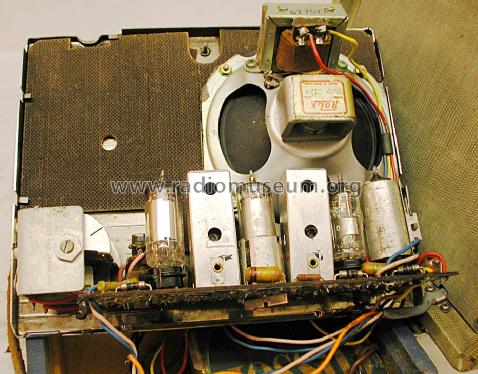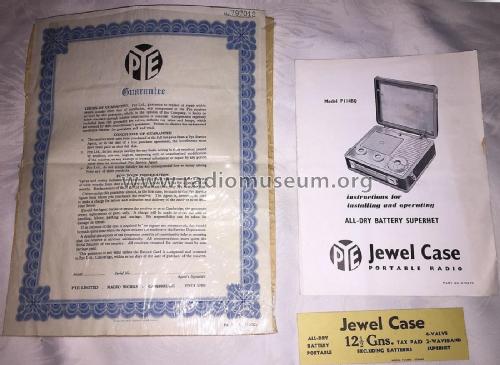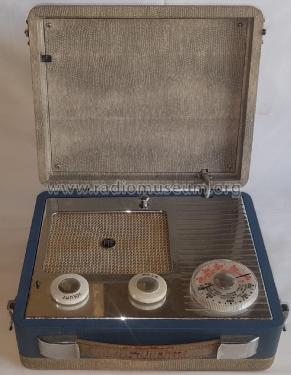Jewel Case P114BQ
Pye Ltd., Radio Works; Cambridge
- País
- Gran Bretaña (GB)
- Fabricante / Marca
- Pye Ltd., Radio Works; Cambridge
- Año
- 1955
- Categoría
- Radio - o Sintonizador pasado WW2
- Radiomuseum.org ID
- 72418
Haga clic en la miniatura esquemática para solicitarlo como documento gratuito.
- Numero de valvulas
- 4
- Principio principal
- Superheterodino en general; ZF/IF 470 kHz
- Número de circuitos sintonía
- 6 Circuíto(s) AM
- Gama de ondas
- OM y OL
- Tensión de funcionamiento
- Pilas / 90 & 1.5 Volt
- Altavoz
- Altavoz dinámico (de imán permanente) / Ø 5 inch = 12.7 cm
- Potencia de salida
- 0.5 W (unknown quality)
- Material
- Cuero/Tela/ Plástico sobre otros materiales
- de Radiomuseum.org
- Modelo: Jewel Case P114BQ - Pye Ltd., Radio Works;
- Forma
- Portátil > 20 cm (sin la necesidad de una red)
- Ancho, altura, profundidad
- 240 x 205 x 100 mm / 9.4 x 8.1 x 3.9 inch
- Anotaciones
-
Cost of radio new £13 2s 6d, tax paid.
Case in 3 color schemes: Lid & base / Band
- White squares on green / Dark red
- White pattern on lilac / White polka dots on grey
- Grey lizard / Blue.
The radio has no model plate and only has "PYE" on the centre of the speaker cloth. Auctions and at least one contemporary advert refer to a PE114BQ. There is no known difference hence only one model entry. This is the 2nd "Jewel Case model"Gewicht ohne Batterien 2,3 kg
- Peso neto
- 2.3 kg / 5 lb 1.1 oz (5.066 lb)
- Precio durante el primer año
- 13.00 GBP
- Procedencia de los datos
- -- Original-techn. papers.
- Mencionado en
- Attaché Radios, Mark Johnson 2005, BVWS GB (p.42)
- Documentación / Esquemas (1)
- Trader sheet 1253
- Autor
- Modelo creado por Keith Watt. Ver en "Modificar Ficha" los participantes posteriores.
- Otros modelos
-
Donde encontrará 634 modelos, 490 con imágenes y 342 con esquemas.
Ir al listado general de Pye Ltd., Radio Works; Cambridge
Colecciones
El modelo Jewel Case es parte de las colecciones de los siguientes miembros.
- Mark Andrews (GB)
- Ekrem Cengiz Bilgin (TR)
- Karel De Reus † (NL)
- Karl Josef Hahn (D)
- Francis Hall (D)
- Jörg Holtzapfel (D)
- Volker Jeschkeit (I)
- Anthony Jordan (GB)
- Jouko Laukkanen (FIN)
- Sofronios Markidis (GR)
- Bill Morris (USA)
- Manfred Rathgeb (D)
- Dieter Schulte-Kulkmann (D)
- José Manuel Silvestre (P)
- Noel Sutherland (AUS)
- Keith Watt (GB)
- Michael Watterson (IRL)
Museos
El modelo Jewel Case se puede ver en los siguientes museos.
Contribuciones en el Foro acerca de este modelo: Pye Ltd., Radio: Jewel Case P114BQ
Hilos: 2 | Mensajes: 2
Seit 3 Jahren schaut es mich an, das Schmuckkästchen. Aber es braucht eine Anodenbatterie von 90V und die ist hier nicht zu haben. Nicht einmal ein Labornetzgerät, das wenigstens auf 50V hinauf ginge. Also sitzt es da und schaut mich an.
Nachdem ich ein bisschen auf einer englischen Sammlerseite gelesen habe über die ‚Waxies‘, die meist schlecht sind, hole ich das Wunderding hervor. Erst einmal versuchen. Zusammengesteckte 9Volt-Batterien erzeugen mir schon einmal 54V, eine doppelte D-Zelle gibt die 1,5V-Spannungsversorgung. Es tut sich, ausser Schab- und Kratzgeräuschen, nichts.
Die berüchtigten Kondensatoren nun sind kleine, schmierige Röhrchen, denen keiner vertraut, der je eines davon angefasst. Es gibt derer mehr, als ich zuerst finde, aber zuletzt sind alle 5 ersetzt. Auch der Elektrolyt wird resolut entfernt, dem traue ich fast noch weniger.
Jetzt langwellt und mittelwellt es wieder. Aber die Schatulle muss auch zu. Nur so bewahrt man sich den Schatz, nämlich das Batterieleben. Der Ausschalter wird aktiv, wenn man die Klappe dichtmacht, also nur, wenn der Deckel zu ist. Dazu müssen Anodenbatterie und Heizungsbatterie klein genug sein, dass sie mit dem Kabelsalat in den vorgesehen Raum passen.
Es gibt bestimmt stilechtere Lösungen, aber meine Lösung funktioniert – und der Deckel lässt sich brav schliessen.
Man macht den Deckel auf: es langwellt im Jahre des Herrn 2021. Man schliesst den Deckel: das Langwellen hat ein Ende, ganz und gar wie im Jahr 1955!
Bruce Cohen, 23.Mar.21
This is the second portable set Pye released called the "Jewel Case". It may have been variously advertised as "P114BQ", "PE 114BQ" or "Jewel Case". The first "Jewel Case" is the Pye P131MBQ was marketed as the "Jewel Case" and called "Jewel Case" on Pye Service sheet (early 1955 ior maybe late 1954). It's a larger cabinet (styled similarly) using a chassis with integral mains power supply, "tag strips" and "Point to Point" wiring. This model (P114BQ) is one of Pye's first PCB based sets. The Pye P131MBQ also has the chrome steel panel, but otherwise is different with dial cord and linear scale. The Chromed steel panel on the Mains/Battery also serves as a "head sink" for the LT supply HT dropper resistor.
Some thoughts
Is the PE 114BQ really a different model or was that just an advertising leaflet for the P114BQ?
Example the Pye P131MBQ was marketed as the "Jewel Case" and the Pye Invicta branded "Invicta 26" was variously marketed by Pye as Vicki and "Vicki 26"
The Invicta 28 from Pye is identical chassis to P114BQ as is the PAM712 (PAM716 also has mains). The Invicta 29 is also same chassis, not the older Pye P131MBQ "Jewel Case" (MB = Mains & Battery) but like one of the PAM (Pamphonic simply a PAM label for Pye by 1955) PAM716? has the mains as a separate Chassis and a three way switch on same cabinet.
The battery only Invicta 28 and battery only PAM712 only differ to P114BQ in case and year of manufacture. The Mains versions unlike Pye P131MBQ (Mains /Battery Jewel case, no PCB, vs "Jewel Case" P114BQ) are just the battery only models with an extra Mains subchassis and extra switch on same case and front panel.
(The Pye PAM710 was unrelated, being the first UK transistor set)
Pye strangely didn't put model plates on most Battery Portables. Vidor and Ever Ready at least added the Model name to battery guide label though some Ever Ready do have the Model name outside or even on the front. The letter "E" often means "Export" or Eire (Ireland). Pye did make sets in Ireland (as did Philips and Murphy in 1940s and 1950s). But the UK Pye 39 J/H (no Magic Eye) and Pye 39 JH/E (Magic Eye) differ on the scales, as the Pye 39 JH/E has "Dundrum" and "Ireland" on the scale. Of course "E" may be for magic eye and there may be a UK version of 39 JH/E! In any case no distingushing difference is known for "PE 114BQ" and "P114BQ". They can only be indentified at all by appearance, lacking a Model name even on PCB or battery instructions.
Even the "Maker" name is understated
- Pye Models: Small round Pye badge
- Pye Invicta Models: Prancing pony on small round badge
- Pye Pamphonic Models: Small badge with PAM or larger badge with Pamphonic
Just for completeness, the Pye P31MBQ (Mains+ Battery) and Pye P31BQ (battery only) appear to be the predecessors to this range using the DK91 DF91 DAF91 DL92 tubes but with geared tuning drive unlike P114BQ, Invicta28/29 and PAM712/716. (all DK96, DF96, DAF96 and DL96),
Michael Watterson, 03.Jul.12


